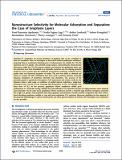Por favor, use este identificador para citar o enlazar a este item:
http://hdl.handle.net/10261/172756COMPARTIR / EXPORTAR:
 SHARE SHARE
 CORE
BASE CORE
BASE
|
|
| Visualizar otros formatos: MARC | Dublin Core | RDF | ORE | MODS | METS | DIDL | DATACITE | |

| Título: | Nanostructure Selectivity for Molecular Adsorption and Separation: The Case of Graphyne Layers |
Autor: | Apriliyanto, Y. B.; Faginas-Lago, N.; Lombardi, A.; Evangelisti, S.; Bartolomei, Massimiliano CSIC ORCID ; Leininger, Theodor; Pirani, F. | Fecha de publicación: | 21-jun-2018 | Editor: | American Chemical Society | Citación: | Journal of Physical Chemistry C 122: 16195-16208 (2018) | Resumen: | Graphynes are porous derivatives of graphene that can be considered as ideal 2D nanofilters. Here, we investigate by theoretical methods graphtriyne multilayers, proposing them as membranes featuring pores of subnanometer size suitable for CO/N separation and CO uptake. The potential energy surfaces, representing the intermolecular interactions within the CO/N gaseous mixtures and between the graphtriyne layers and the molecules, have been formulated in an internally consistent way, by adopting potential models far more accurate than the traditional Lennard-Jones functions, routinely used to predict static and dynamical properties of matter. The new force fields so obtained and tested on accurate ab initio calculations have been used to perform extensive molecular dynamics simulations of membrane selectivity and adsorption. The accuracy of the potentials granted a quantitative description of the interactions and realistic results for the dynamics under a wide range of conditions of applied interest, indicating a single-layer permeation ratio CO/N of 4.25 (meaning that permeations of CO are typically 4.25 times those of N). At low pressure, graphtriyne bilayer membranes exhibit good performances as a molecular sieving candidate for postcombustion CO separation because of a high permeance and a relatively good selectivity. On the other hand, graphtriyne trilayer membranes present a relatively high interlayer adsorption selectivity and a high CO uptake. Such properties make these graphyne nanostructures versatile materials competitive with other carbon-based adsorbing membranes suitable to cope with post-combustion CO emissions. Moreover, guidelines for the extension of the proposed methodology to carbon nanostructures and other gaseous mixtures of relevance for atmosphere and combustion are also provided. | Descripción: | 14 pags., 15 figs., 4 tabs. | Versión del editor: | http://doi.org/10.1021/acs.jpcc.8b04960 | URI: | http://hdl.handle.net/10261/172756 | DOI: | 10.1021/acs.jpcc.8b04960 | Identificadores: | doi: 10.1021/acs.jpcc.8b04960 issn: 1932-7455 |
| Aparece en las colecciones: | (CFMAC-IFF) Artículos |
Ficheros en este ítem:
| Fichero | Descripción | Tamaño | Formato | |
|---|---|---|---|---|
| Nanostructure Selectivity.pdf | 4,26 MB | Adobe PDF |  Visualizar/Abrir | |
| Supporting Information.pdf | 1,87 MB | Adobe PDF |  Visualizar/Abrir |
CORE Recommender
SCOPUSTM
Citations
31
checked on 28-abr-2024
WEB OF SCIENCETM
Citations
30
checked on 19-feb-2024
Page view(s)
309
checked on 05-may-2024
Download(s)
471
checked on 05-may-2024
Google ScholarTM
Check
Altmetric
Altmetric
NOTA: Los ítems de Digital.CSIC están protegidos por copyright, con todos los derechos reservados, a menos que se indique lo contrario.
